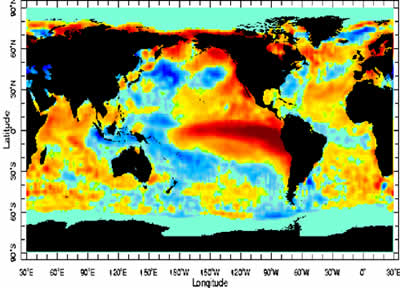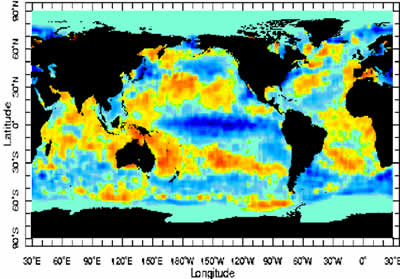WMO El Niño/La Niña Updates
Latest WMO El Niño/La Niña Update (September 2024)
As of mid-August 2024, the tropical Pacific remains in a neutral state of the El Niño–Southern Oscillation (ENSO). The WMO Global Producing Centres of Long-Range Forecasts anticipate a possible transition to La Niña, with approximately a 55% chance in September-November, increasing to 60% during the subsequent three-month periods of October-December, November-January and December-February. The chance of ENSO neutral conditions persisting is estimated at 45% for September-November and 40% thereafter. The chance of El Niño developing during the forecast period is near zero. National Meteorological and Hydrological Services (NMHSs) will closely monitor changes in the state of ENSO over the coming months and provide updated outlooks, as needed.
ENSO-neutral conditions (i.e., neither El Niño nor La Niña), were observed over the past three months. As of mid-August 2024, the equatorial Pacific Ocean continues to experience ENSO-neutral conditions. During the week centered on 14 August 2024, sea surface temperatures across the equatorial Pacific ranged between0.3 below and 0.6 degrees Celsius above normal. Over the past few months, cold subsurface temperatures have persisted in the eastern equatorial Pacific Ocean, extending to the surface. Negative subsurface temperature anomalies continue to be present at depth in the central Pacific Ocean, while slightly above-average temperatures are observed from the surface to a depth of 50 meters in the western and central Pacific. Overall, negative subsurface temperature anomalies have weakened since early August 2024. The overlying atmospheric conditions, including surface and upper-level winds and patterns of cloudiness and rainfall, remain broadly consistent with ENSO neutral conditions. The Equatorial Southern Oscillation Index (ESOI, a measure of the standardized Equatorial Pacific (80°W-130°W; 5°N-5°S) minus Indonesia (90°E-140°E; 5°N-5°S) sea-level pressure difference) was within ENSO-neutral range for the month of July 2024. The trade winds were close to average across the tropical Pacific, and normal atmospheric convection has been observed in the central Pacific. On the whole therefore, observed oceanic and atmospheric conditions currently indicate the existence of ENSO-neutral conditions.
National Meteorological and Hydrological Services (NMHSs) will closely monitor changes in the state of ENSO over the coming months and provide updated outlooks, as needed. Read more >>
An archive of all WMO El Niño/La Niña Updates issued so far, is available here below:
El Niño/La Niña Background
 |
 |
Research conducted over recent decades has shed considerable light on the important role played by interactions between the atmosphere and ocean in the tropical belt of the Pacific Ocean in altering global weather and climate patterns. During El Niño events, for example, sea temperatures at the surface in the central and eastern tropical Pacific Ocean become substantially higher than normal. In contrast, during La Niña events, the sea surface temperatures in these regions become lower than normal. These temperature changes are strongly linked to major climate fluctuations around the globe and, once initiated, such events can last for 12 months or more. The strong El Niño event of 1997-1998 was followed by a prolonged La Niña phase that extended from mid-1998 to early 2001. El Niño/La Niña events change the likelihood of particular climate patterns around the globe, but the outcomes of each event are never exactly the same. Furthermore, while there is generally a relationship between the global impacts of an El Niño/La Niña event and its intensity, there is always potential for an event to generate serious impacts in some regions irrespective of its intensity.
Forecasting and Monitoring the El Niño/La Niña Phenomenon
The forecasting of Pacific Ocean developments is undertaken in a number of ways. Complex dynamical models project the evolution of the tropical Pacific Ocean from its currently observed state. Statistical forecast models can also capture some of the precursors of such developments. Expert analysis of the current situation adds further value, especially in interpreting the implications of the evolving situation below the ocean surface. All forecast methods try to incorporate the effects of ocean-atmosphere interactions within the climate system.
The meteorological and oceanographic data that allow El Niño and La Niña episodes to be monitored and forecast are drawn from national and international observing systems. The exchange and processing of the data are carried out under programmes coordinated by the World Meteorological Organization.
WMO El Niño/La Niña Update
WMO El Niño/La Niña Update is prepared on a quasi-regular basis (approximately once in three months) through a collaborative effort between WMO and the International Research Institute for Climate and Society (IRI) as a contribution to the United Nations Inter-Agency Task Force on Natural Disaster Reduction. It is based on contributions from the leading centres around the world dealing with this phenomenon. The contributors include:
- African Centre of Meteorological Application for Development (ACMAD)
- Asia-Pacific Economic Cooperation (APEC) Climate Centre (APCC)
- Australian Bureau of Meteorology (BoM)
- Australian Centre for Sustainable Catchments of the University of Southern Queensland
- Badan Meteorologi Klimatologi dan Geofisika (BMKG) – the Meteorological, Climatological and Geophysical Agency of Indonesia
- Centro Internacional para la Investigación del Fenómeno El Niño (CIIFEN)
- China Meteorological Administration (CMA)
- Climate Prediction Center (CPC) and National Weather Service (NWS) of the National Oceanic and Atmospheric Administration (NOAA) of the United States of America
- Climate Variability and Predictability (CLIVAR) project of the World Climate Research Programme (WCRP)
- Comisión Permanente del Pacífico Sur (CPPS)
- Consortium for Capacity Building (CCB), University of Colorado, USA
- El Comité Multisectorial encargado del Estudio Nacional del Fenómeno El Niño (ENFEN) of Peru
- European Centre for Medium Range Weather Forecasts (ECMWF)
- Fiji Meteorological Service
- India Meteorological Department (IMD)
- Indian Institute of Science (IISc)
- IGAD (Inter Governmental Authority on Development) Climate Prediction and Applications Centre (ICPAC)
- Instituto Nacional de Meteorologia e Hidrologia (INAMHI) of Ecuador
- International Monsoons Project Office (IMPO)
- International Research Institute for Climate and Society (IRI)
- Japan Meteorological Agency (JMA)
- Korea Meteorological Administration (KMA)
- Mauritius Meteorological Services (MMS)
- Météo France
- Met Office in the United Kingdom (UKMO)
- National Center for Atmospheric Research (NCAR) of the United States of America
- National Institute of Water and Atmospheric Research (NIWA) of New Zealand
- Southern African Development Community Climate Services Centre (SADC-CSC)
- Tasmanian Institute of Agricultural Research (TIAR, a Joint Venture between the University of Tasmania and the Tasmanian Government, Australia)
Archive of WMO El Niño/La Niña Updates
The following is the archive of WMO El Niño/La Niña Updates, including the latest one, prepared through a collaborative effort between the WMO and the International Research Institute for Climate and Society (IRI) as a contribution to the United Nations Inter-Agency Task Force on Natural Disaster Reduction. They have been prepared based on contributions of many National Meteorological and Hydrological Services (NMHSs) and other agencies/experts. Please see each update for the specific contributions.
